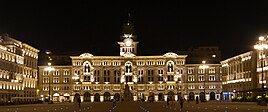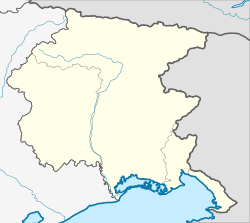
Back Triëst Afrikaans Triest ALS Trieste AN ترييستي Arabic ترييستى ARZ Trieste AST Triest Azerbaijani تریسته AZB Triésté BAN Triests BAT-SMG
Trieste
Trst (Slovene) | |
|---|---|
| Comune di Trieste | |
| Coordinates: 45°39′1″N 13°46′13″E / 45.65028°N 13.77028°E | |
| Country | Italy |
| Region | Friuli-Venezia Giulia |
| Province | Trieste |
| Frazioni | Banne (Bani), Barcola (Barkovlje), Basovizza (Bazovica), Borgo San Nazario, Cattinara (Katinara), Conconello (Ferlugi), Contovello (Kontovel), Grignano (Grljan), Gropada (Gropada), Longera (Lonjer), Miramare (Miramar), Opicina (Opčine), Padriciano (Padriče), Prosecco (Prosek), Santa Croce (Križ), Servola (Škedenj), Trebiciano (Trebče) |
| Government | |
| • Mayor | Roberto Dipiazza (FI) |
| Area | |
• Total | 84.49 km2 (32.62 sq mi) |
| Elevation | 2 m (7 ft) |
| Population (2018)[2] | |
• Total | 204,338 (Comune) 234,638 (Urban) 418,000 (Metro) |
| Demonym(s) | English: Triestine or Triestino Italian: triestino (m.), triestina (f.) |
| Time zone | UTC+1 (CET) |
| • Summer (DST) | UTC+2 (CEST) |
| Postal code | 34100 |
| Dialing code | 040 |
| ISTAT code | 032006 |
| Patron saint | St. Justus of Trieste |
| Saint day | 3 November |
| Website | comune.trieste.it |
Trieste (/triˈɛst/ tree-EST,[3] Italian: [triˈɛste] ⓘ; Slovene: Trst [tə̀ɾst, tə́ɾst])[a] is a city and seaport in northeastern Italy. It is the capital and largest city of the autonomous region of Friuli-Venezia Giulia, as well as of the regional decentralization entity of Trieste.
Trieste is located at the head of the Gulf of Trieste, on a narrow strip of Italian territory lying between the Adriatic Sea and Slovenia; Slovenia lies close, at approximately 8 km (5 mi) east and 10–15 km (6–9 mi) southeast of the city, while Croatia is about 30 km (19 mi) to the south of the city.
The city has a long coastline and is surrounded by grassland, forest, and karstic areas. In 2022, it had a population of 204,302.[2]
Trieste belonged as Triest to the Habsburg monarchy from 1382 until 1918. In the 19th century, the monarchy was one of the Great Powers of Europe and Trieste was its most important seaport. As a prosperous trading hub in the Mediterranean region, Trieste grew to become the fourth largest city of the Austro-Hungarian Empire (after Vienna, Budapest, and Prague). At the turn of the 20th century, it emerged as an important hub for literature and music. Trieste underwent an economic revival during the 1930s, and the Free Territory of Trieste became a major site of the struggle between the Eastern and Western blocs after the Second World War.
A deep-water port, Trieste is a maritime gateway for northern Italy, Germany, Austria and Central Europe. It is considered the end point of the maritime Silk Road, with its connections to the Suez Canal and Turkey. Since the 1960s, Trieste has emerged as a prominent research location in Europe because of its many international organisations and institutions. The city lies at the intersection of Latin, Slavic and Germanic cultures, where Central Europe meets the Mediterranean Sea, and is home to diverse ethnic groups and religious communities.
A scholarly area, Trieste has the highest percentage of researchers, per capita, in Europe.[4] Città della Barcolana ("City of the Barcolana"), Città della bora ("City of the bora"), Città del vento ("City of Wind"), "Vienna by the sea" and "City of Coffee" are epithets used to describe Trieste.
- ^ "Superficie di Comuni Province e Regioni italiane al 9 ottobre 2011". Italian National Institute of Statistics. Retrieved 16 March 2019.
- ^ a b "Population of Trieste 2022". AZ Nations: World countries population. 2022. Retrieved 1 May 2022.
- ^ "Trieste". Collins English Dictionary. HarperCollins. Retrieved 21 September 2012.; "Trieste". Lexico UK English Dictionary. Oxford University Press. Archived from the original on 1 August 2019.
- ^ G. Bar "Trieste, è record europeo di ricercatori: 37 ogni mille abitanti. Più della Finlandia", In: il Fatto Quotidiano, 26 April 2018.
Cite error: There are <ref group=lower-alpha> tags or {{efn}} templates on this page, but the references will not show without a {{reflist|group=lower-alpha}} template or {{notelist}} template (see the help page).










